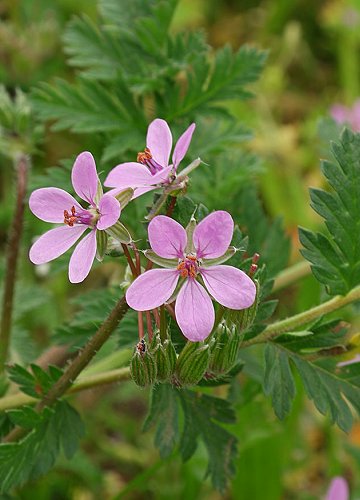
|
|
Storkís Bill
(Erodium cicutarium).
Leaves and flowers.
|
Stork's Bill - Erodium cicutarium
Erodium cicutarium, also known as common stork's-bill, redstem filaree, redstem stork's bill or pinweed, is a herbaceous annual
- or in warm climates, biennial - member of the family Geraniaceae of flowering plants. It is native to Macaronesia, temperate Eurasia and north and northeast Africa, and was introduced to North America in the eighteenth century, where it has since become naturalized, particularly of the deserts and arid grasslands of the southwestern United States.
Stork's Bill is one of those little plants
that's not supposed to grow locally but does here and there. Native to the Mediterranean area, it came here with the Spaniards and later proliferated with the planting of alfalfa, whose fields it likes to inhabit. Now
it's naturalized throughout North America. In northern states and Canada. It's an annual. In southern and southwest states, a biennial. It is particularly common in deserts and arid grasslands. Colorado calls it a noxious weed.
It flowers from May until August. Common stork's-bill can be found in bare, sandy, grassy places both inland and around the coasts.
Erodium cicutarium is an erect to decumbent, hairy, sticky annual plant producing numerous stems usually 10 - 15cm tall, occasionally to 40cm. The stems bear bright pink flowers, which often have dark spots on the bases. The flowers are arranged in a loose cluster and have ten filaments
- five of which are fertile - and five styles. The leaves are pinnate to pinnate-pinnatifid, with hairy stems. The long seed-pod, shaped like the bill of a stork, bursts open in a spiral when ripe, sending the seeds (which have long tails called awns) into the air.
Scientifically the plant called Erodium cicutarium. Erodium is from the Greek word Erodios, meaning heron.
The plant called heron because of the resemblance of the fruit to the bill of the
heron (Stork's Bill).
Cicutarium - Latin - means resembling the genus Cicuta, the Poison Hemlock, and it does. The significant difference between them when young is the
Stork's Bill has hairy stems. The Poison Hemlock is not hairy. Donít mistake the two. Poison Hemlock is deadly. Remember,
Stork's Bill has hairy stems and a basal rosette.
The entire plant is edible raw or cooked, and of course as usual, young and tender is better than old and tough. Though in the geranium family when picked young it has a flavor similar to parsley.
The young leaves are edible raw or cooked as a potherb. Harvested before the plant flowers, they are tasty and nutritious. The leaves are added to salads, sandwiches, soups etc, they can be used in recipes that call for leaves of beet, plantain, sow thistle or
amaranth
According to John Lovell's Honey Plants of North America (1926), "the pink flowers are a valuable source of honey (nectar), and also furnish much pollen".
The whole plant is astringent and haemostatic. It has been used in the treatment of uterine and other bleeding. The root and leaves have been eaten by nursing mothers to increase the flow of milk.
Externally, the plant has been used as a wash on animal bites, skin infections etc.
A tea made from the leaves is diaphoretic and diuretic An infusion has been used in the treatment of typhoid fever. The leaves are soaked in water and used as a bath for the treatment of rheumatism.
A poultice of the chewed root has been applied to sores and rashes.
The seeds contain vitamin K, a poultice of them is applied to gouty typhus.
Incidentally,
Erodium cicutarium has a few other claims to fame. The entire plant can be used as a green dye and does not need a mordant to set the color. The old styles (tails on seeds) are humidity sensitive and can used in hygrometers and as weather indicators. Also the powdered plant
(dried plant powder) has been mixed with watermelon seeds during storage and planting in order to prevent watermelon diseases.
Source:
https://en.wikipedia.org/wiki/Erodium_cicutarium
http://tropical.theferns.info/viewtropical.php?id=Erodium+cicutarium
https://www.eattheweeds.com/
erodium-circutarium-geranium-carolinianum-two-bills-you-want-to-get-2/
